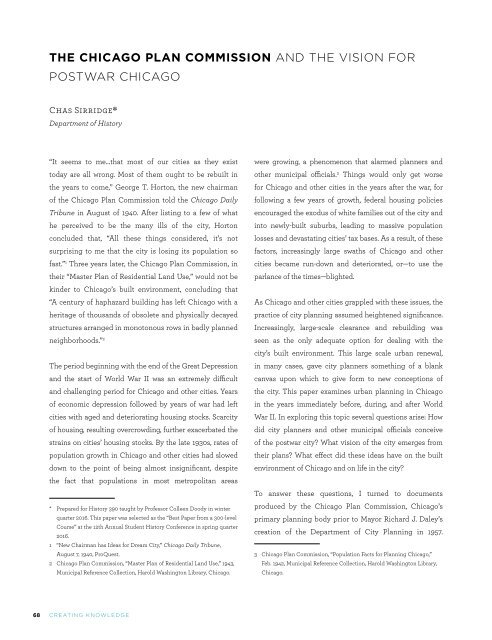UNDERGRADUATE
Ycb5305N2JX
Ycb5305N2JX
Create successful ePaper yourself
Turn your PDF publications into a flip-book with our unique Google optimized e-Paper software.
The Chicago Plan Commission played a predominantly<br />
advisory role, establishing guidelines and principles and<br />
providing review for buildings and developments, but<br />
did not actually undertake buildings and developments<br />
directly. Nevertheless, the plans and documents produced<br />
by the Chicago Plan Commission during this period<br />
demonstrate a clear vision for the postwar city. Their plans<br />
endorsed what was considered to be the soundest and<br />
most effective modern planning principles. Whether or<br />
not these plans came to fruition, the planning and design<br />
principles they promoted would come to be embraced<br />
by architects, developers, and builders in urban renewal<br />
projects throughout the postwar period.<br />
Through the documents and plans they produced during<br />
this time, the Chicago Plan Commission introduced and<br />
promoted a new and radically different vision for the city.<br />
The members of the Chicago Plan Commission, during<br />
this period, envisioned a city of modern high-rises and<br />
row houses arranged in geometric clusters surrounded<br />
by amble green space with winding, curvilinear streets,<br />
minimal traffic arteries, and commercial enterprises<br />
grouped together in suburban-style shopping centers<br />
with off-street parking facilities away from residential<br />
areas—a far cry from the dense development of two-flats,<br />
three-flats, bungalows, and courtyard apartments along a<br />
gridiron street pattern that constituted the reality of midcentury<br />
Chicago.<br />
Two works that deal with the history of urban planning<br />
in Chicago are D. Bradford Hunt and Jon B. DeVries’<br />
Planning Chicago and Joseph P. Schwieterman and Dana<br />
M. Caspall’s The Politics of Place: A History of Zoning in<br />
Chicago. In Planning Chicago, Hunt and Devries examine<br />
urban planning in Chicago beginning with the creation<br />
of the Department of City Planning by Mayor Richard<br />
J. Daley in 1957. Hunt and Devries approach planning<br />
largely from the perspective of politics and policy,<br />
focusing on the role that different actors and groups<br />
played in planning postwar Chicago. Politics of Place<br />
traces the history of zoning and land-use regulation in<br />
Chicago, from the city’s founding to the adoption of a new<br />
zoning code in 2004.<br />
Another work that deals with urban planning and urban<br />
renewal in Chicago is Michael Carriere’s “Chicago, the<br />
South Side Planning Board, and the Search for (Further)<br />
Order: Toward an Intellectual Lineage of Urban Renewal<br />
in Postwar America.” In this article, Carriere examines how<br />
the members of the South Side Planning Board used the<br />
concept of social disorganization to interpret the “blight”<br />
that they saw in African American neighborhoods, how<br />
they used these ideas to try to legitimize large-scale<br />
urban renewal, and how these ideas influenced the ideas,<br />
theories, principles, and underlying vision of urban<br />
planning at the time. 4<br />
The city of Chicago has played a major role in the history<br />
and development of city planning. The City Beautiful<br />
movement—epitomized by the 1893 Columbian World’s<br />
Exhibition and culminating in Daniel Burnham’s 1909<br />
Plan of Chicago—that emerged in Chicago around the<br />
turn of the twentieth century represented a watershed<br />
moment in the history and development of city planning.<br />
Robert C. Klove, assistant chief of the geography division<br />
of the Bureau of the Census and a member of the<br />
Chicago Plan Commission, explained in a 1948 article<br />
in the Geographical Review how, “In the early years of<br />
the twentieth century, Chicago played a notable part in<br />
stimulating the development of city planning not only in<br />
the United States but throughout the rest of the world as<br />
well. The Chicago World’s Fair of 1893 awakened interest<br />
in civic improvements, parks, and thoroughfares, and the<br />
trend in planning known as the ‘city beautiful’ began.” 5<br />
Albert Lepawsky, writing eight years earlier in the Journal<br />
of Land and Public Utility Economics, told how Chicago<br />
4 Carriere, Michael, “Chicago, the South Side Planning Board, and the<br />
Search for (Further) Order: Toward an Intellectual Lineage of Urban<br />
Renewal in Postwar America,” Journal of Urban History 39 no. 3 (2012):<br />
411–432.<br />
5 Robert C. Klove, “City Planning in Chicago: A Review,” Geographical<br />
Review Vol. 38, no. 1 (Jan. 1948), 127.<br />
DEPAUL UNIVERSITY<br />
69


